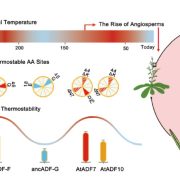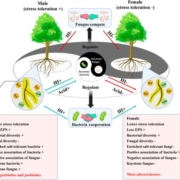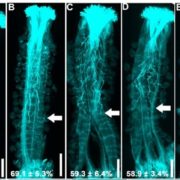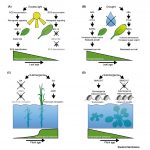Longer telomeres, earlier flowering: Natural variation in plant telomere length is associated with flowering time (Plant Cell)
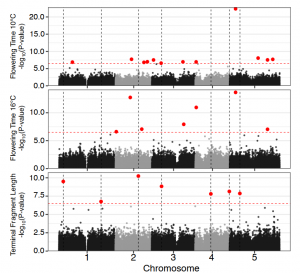 Telomeres (from Greek words meaning “end part”) are highly repetitive DNA sequences at chromosome ends that guard against degeneration during cell division. Though all eukaryotes possess telomeres, extensive interspecific variation exists for telomere lengths (300bp in yeast to 150kb in tobacco). Telomere length differences could have fitness effects subject to natural selection. In mammals, telomere shortening rates powerfully predict species life span, as shortening telomeres trigger aging. But how does telomere length evolution affect plant life-history strategies? In this Breakthrough Report, Choi et al. reveal that natural intraspecific variation in plant telomere length is associated with a crucial life-history trait: flowering time. A GWAS revealed thirteen regions associated with telomere length variation in Arabidopsis; one contains the telomerase gene TERT, and population genomic analysis supports a selective sweep at this region associated with longer telomeres. Among Arabidopsis ecotypes, the authors found a negative correlation between telomere length and latitude, and between telomere length and flowering time. In other words, Arabidopsis plants with longer telomeres flower earlier, and the same phenomenon is found in maize and rice, indicating that this relationship may be widespread. Possibly, longer telomeres could be more adaptive in plants with faster developmental rates that facilitate earlier flowering. This fascinating discovery indicates that chromosomal structure may be an adaptive trait connected with plant life-history strategies. (Summary by Caroline Dowling @CarolineD0wling) Plant Cell 10.1093/plcell/koab022
Telomeres (from Greek words meaning “end part”) are highly repetitive DNA sequences at chromosome ends that guard against degeneration during cell division. Though all eukaryotes possess telomeres, extensive interspecific variation exists for telomere lengths (300bp in yeast to 150kb in tobacco). Telomere length differences could have fitness effects subject to natural selection. In mammals, telomere shortening rates powerfully predict species life span, as shortening telomeres trigger aging. But how does telomere length evolution affect plant life-history strategies? In this Breakthrough Report, Choi et al. reveal that natural intraspecific variation in plant telomere length is associated with a crucial life-history trait: flowering time. A GWAS revealed thirteen regions associated with telomere length variation in Arabidopsis; one contains the telomerase gene TERT, and population genomic analysis supports a selective sweep at this region associated with longer telomeres. Among Arabidopsis ecotypes, the authors found a negative correlation between telomere length and latitude, and between telomere length and flowering time. In other words, Arabidopsis plants with longer telomeres flower earlier, and the same phenomenon is found in maize and rice, indicating that this relationship may be widespread. Possibly, longer telomeres could be more adaptive in plants with faster developmental rates that facilitate earlier flowering. This fascinating discovery indicates that chromosomal structure may be an adaptive trait connected with plant life-history strategies. (Summary by Caroline Dowling @CarolineD0wling) Plant Cell 10.1093/plcell/koab022


